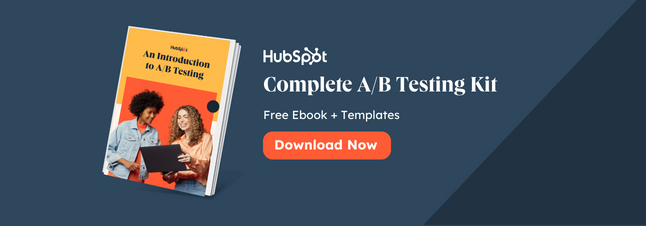- Like
- SHARE
- Digg
- Del
- Tumblr
- VKontakte
- Flattr
- Buffer
- Love This
- Save
- Odnoklassniki
- Meneame
- Blogger
- Amazon
- Yahoo Mail
- Gmail
- AOL
- Newsvine
- HackerNews
- Evernote
- MySpace
- Mail.ru
- Viadeo
- Line
- Comments
- Yummly
- SMS
- Viber
- Telegram
- JOIN
- Skype
- Facebook Messenger
- Kakao
- LiveJournal
- Yammer
- Edgar
- Fintel
- Mix
- Instapaper
- Copy Link
Choosing the right pricing for your product is a little bit like Goldilocks.
Too high, and you risk alienating a large majority of your potential customers.
Too low, and you likely won’t have enough revenue to run a sustainable business. Plus, consumers might not value your product or brand as highly if they see a much lower cost than competitors’.
But how can you get it just right?
That’s what we’re going to explore in this post. Let’s dive into the pros and cons of A/B testing your pricing — and how to do it. Plus, some alternatives to A/B testing your pricing if you’ve determined the weaknesses outweigh the strengths.
Price Testing
Price testing is when you conduct a test to determine the ideal price for attracting prospects and increasing revenue. One type of price testing is A/B testing different prices for a given product. Another type is to pilot a pricing model for one region.
Product pricing is undeniably one of the most important decisions for your company.
Your price can determine how consumers see you in the marketplace — for instance, Ray Bans’ expensive sunglasses suggests they’re higher-quality than the ones I can find at CVS. Sure, the price might limit the amount of total consumers Ray Ban attracts, but the price also attracts high-intent prospects based on perceived value.
This premise is known as value-based pricing: a strategy that chooses pricing based on how much a consumer believes a product is worth. I believe Ray Ban sunglasses are high-quality, and more importantly, I have a good perception of the brand, which makes me feel the sunglasses are worth the hefty price.
Value-based pricing is most impactful if your brand reputation is good. If you’re a newcomer to the marketplace, it might be harder to persuade consumers that your product is worth the expense — people need to know (and love) your brand, first.
There are a few other factors to consider when choosing a price, including what competitors’ are charging (competition-based pricing), or how much it will cost you to produce your product or service, plus how much you want to profit (cost-plus pricing).
To learn more about different pricing strategies, take a look at The Ultimate Guide to Pricing Strategies.
However, even once you’ve chosen a pricing strategy that works for your business, you might be unsure if the specific dollar price is going to return maximum revenue.
For instance, your pricing strategy might show a range of $50-$60 is best for your product. However, you need to find the “sweet spot” within that range. Charge it for $50, and you might be missing out on the revenue you could’ve received if you’d charged it at $60.
Charge it for $60, alternatively, and you might limit the amount of people willing to purchase your product — which could also decrease the amount of revenue you can receive.
This is where A/B testing comes into play. Let’s explore how to A/B test your pricing, next.
How to A/B Test Your Pricing
It’s important to note — many advise against A/B testing your pricing, for a few reasons.
There are a few major disadvantages or pitfalls associated with A/B testing a price. These include:
- It introduces an element of unfairness to buyers. It doesn’t seem fair that person A is able to purchase your product for less money than person B, which could cause harm to your brand’s reputation. Plus, it could ultimately dissuade a potential buyer from purchasing — for instance, if a prospect pitches a new software solution to her boss for $30/month, and then her boss logs onto the site and sees the product is $50/month, the confusion and frustration over the increase in price could prevent them from purchasing your product at all.
- You’ll have a group of customers paying an outdated price for your product. Let’s say you ultimately decide to go with the $30/month variant of your test — but you already have 40 customers who are paying $50/month. What do you do with them? You’ll need to either migrate them to the $30/month plan and potentially deal with reimbursement requests, or keep them on an outdated model … which could cause frustration and high turnover rates when those customers learn they’re paying more than others.
- It can be difficult to get statistical significance. You need a certain amount of people to purchase both price options for your test to be statistically significant, rather than pure chance. For many SaaS companies or companies that work with larger clients or more complex deals, you likely won’t have enough people to ensure your results are even useful.
- It requires the development of multiple SKUs and other systems functionality, which can be a large (and potentially unrewarded) effort.
However, if you are going to A/B test your pricing, here’s how you’ll want to do it.
1. Choose two different products (or plans) within the same category type.
To ensure you’re being ethical and fair with your prospects, you don’t want to test two different prices on the same product. Consumers will eventually catch that you’re charging different users varying prices, and it could permanently damage your brand’s reputation.
One alternative to this is testing two different products, or plans, within the same category type to see how much people are willing to pay for your product.
For instance, if you sell social media software, you might choose a Basic plan and charge people $50/month. Within this plan, consumers receive 10 social accounts and 1 user. Then, you might choose your Professional plan, and charge people $140/month, which includes 20 social accounts and 2 users.
By doing this, you’re testing how much people are willing to pay for a social management tool, and whether there’s a cut-off. Technically, the Professional plan offers double the value of the Basic plan, but charges more than double each month ($140/month for 20 accounts and 2 users can be broken down to $70 for 10 accounts and 1 user — whereas a Basic plan is $50 for 10 accounts and 1 user).
Then, you’ll want to track if the conversion rates are higher or equal on both Basic and Professional. If there seems to be a drop-off of buyers for the Professional tool, you might want to lower your pricing on that product and see if it can positively impact revenue.
2. Figure out the price points you want to test.
You’ll want to determine the prices you want to test within a given range based on a variety of factors, including competitor pricing and operational costs.
You’re hoping to gauge price sensitivity, or the degree to which demand changes after a certain price point. For instance, you might find if you price your product at $100, the amount of people who will purchase your product drops dramatically.
Ultimately, you want to choose realistic price points to figure out the highest price you can go, while still maintaining the highest number of potential customers.
3. Measure revenue to determine price.
A small but important detail — measure revenue, not conversions, to determine which price wins out on your A/B test.
You’ll likely have much higher conversion rates on lower-priced products, but that doesn’t mean you’re able to hit your revenue goals. If you price a product too low, you might still struggle to meet revenue goals even with thousands of additional customers. This is why it’s important to measure revenue, not conversions.
4. Iterate on results and re-test two new price points, if need be.
If you’ve tested $30/month against $50/month and found $30/month equates to the most conversions and possible revenue, consider re-testing between $30 and $40, or $30 and $35.
Iterating on your results enables you to find a highly specific price point that will provide you with maximum revenue.
5. Choose the price that equates to maximum revenue.
Finally, choose the price point that suggests maximum revenue by determining the highest price that still converts enough customers to meet your business goals.
Alternatives to A/B Testing
If the potential risks associated with A/B testing pricing outweigh the benefits for your own business, there are plenty of alternative options to test a product’s pricing.
For one, you could try A/B testing the pricing page — including different layouts and CTAs — to figure out the best page for optimal conversions and monetization. Maybe your pricing isn’t the issue, but your landing page is.
Alternatively, if you’re releasing a new product, consider launching the product in one market only to gauge market reaction and performance, before rolling the product out on a broader scale. This enables you to make tweaks to your pricing or product before releasing the product to the entire marketplace.
Finally, you might consider conducting a survey and simply asking prospective customers how much they’re willing to pay for a similar product in the industry.
For instance, if you’re selling a website design tool, you might ask: “What features are most important to you in a website design tool?” and, “At what point would a website design tool be too expensive?” or “What is the maximum price you’re willing to pay for a website design tool?”
Ultimately, pricing is about determining your product or service’s value, and how much consumers are willing to pay for that value. It’s an incredibly important factor to consider when running a business, but it’s not something you can A/B test — at least not without potentially losing consumers or damaging your reputation when consumers find different prices every time they visit your site.
If you are interested in A/B testing, we’d suggest using the process to test out the design of your pricing pages or product landing pages. Perhaps by altering how you display your product’s value on a page, you’ll raise the amount consumers are willing to pay.
Originally published Apr 9, 2021 7:00:00 AM, updated April 09 2021




